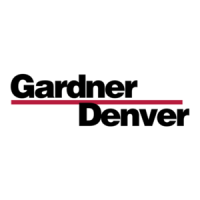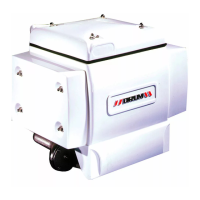The first compressor placed into sequence mode will
become the master. However, since any compressor
first placed into sequence has no way of knowing
whether a master exists, itwill first assume the highest
rotation number available. For example if the number
of units to be sequenced is programmed at four, any
compressor will start out in position four when placed
in sequence mode.
It will then listen on the commu-
nications line for a call from the master.
If no call is received, it will assume position three and
again wait for a call from the master. After another lack
of a master call, it assumes position two. Subsequent-
ly, it assumes position one, which makes it the master.
As soon as a master is established, it immediately at-
tempts to call all other units and assigns them succes-
sive rotation positions. The system is now active.
Before a master is established, the system is not de-
prived of air. This is due to one of the outstanding fea-
tures of the “AUTO SENTRY-ES sequencing system:
pressure control is always executed locally at each
compressor. The effective setpoint for compressor
control is the programmed setpoint minus 3 *(rotation
number – 1). So while a compressor is counting down
towards establishing a master, it is also capable of de-
livering air at a pressure determined by the above for-
mula.
To ensure that two or more machines do not simulta-
neously decrement their rotation numbers and simulta-
neously become masters, place the desired master in
sequence mode first and wait until the first decrement
in rotation number is seen (about 7 seconds). Then
place subsequent compressors in sequence mode. To
dictate the complete initial sequence manually, wait un-
til the previous machine decrements one position and
then place the next desired compressor in sequence
mode. To let the master determine the initial sequence,
simply wait until the master has decremented its rota-
tion number once, and then place all remaining com-
pressors in sequence mode. Remember that once a
master is established, no further self-decrementing is
done by the individual compressors. Instead, they
will
wait until the master assigns them a rotation number.
Rotation numbers are displayed in the bottom display
line, with the mode indication. For example, the mode
indication for the current master is SEQ1; for the first
lag compressor, SEQ2; second lag, SEQ3.
2. HOW THE “AUTO SENTRY-ES” CONTROLS
PRESSURE WHILE SEQUENCING
Each compressor operates exactly the same as if it
were in AUTO mode with one exception: it has a dy-
namic setpoint. The initial setpoint is determined by the
equation shown above. A compressor starts when the
system pressure drops below its programmed reset
point, after waiting for [ ‘LAG START INTERVAL’ times
(rotation number - 1)] seconds. This prevents all lag
13-9/1 0-641
compressors from starting at once. Note that a com-
pressor’s ['LAG START INTERVAL’ times (rotation
number - 1)] timer is not reset to zero until that com-
pressor is started or until another unit in the system
stops. This means that the time for the next lag com-
pressor to come on may be somewhat less than ‘LAG
START INTERVAL’.
EXAMPLE:
In a three compressor sequence system, SET PRES-
SURE = 100 PSI; RESET PRESSURE= 90 PSI; LAG
START INTERVAL = 15 seconds. The lead compres-
sor is running alone, maintaining 100 PSI by modula-
tion when an air tool comes on line and causes the air
demand to exceed the capacity of the lead compressor.
When the pressure drops to 90 PSI, the #2 unit times
out its 15 second timer and starts. It takes 5 additional
seconds for the pressure to rise above 90 PSI. The #3
unit whose timer was initially set at 30 seconds (15x [3
- 1]), has counted down 20 seconds (the total time that
system pressure was below 90 PSI). If air demand in-
creases again, the pressure will have to fall below 90
PSI for only 10 seconds more to start unit #3.
As was previously stated, a lag compressor’s modula-
tion setpoint (PSET for short) is [SET PRESSURE -
3(rotation number -
1)], Thus in the above example,
the first lag compressor (rotation #2) has a PSET of 97
PSI; the second lag, 94 PSI, and so on. But look what
happens in an eight compressor installation: The
eighth compressor will have an initial setpoint of [100
- 3(8 - l)], or 79 PSI. Does this mean that an eight
compressor installation must operate 21 PSI below the
desired operating point when all compressors are run-
ning? NO! This is where the “AUTO SENTRY–ES dy-
namic setpoint control takes over, This is how itworks:
Whenever the system pressure is below the pro-
grammed RESET PRESSURE, the PSET of each lag
compressor is incremented 1 PSI every thirty seconds.
Thus, after a short interval (about five minutes in this
example), the PSET of the last sequenced compressor
will climb until either it equals the RESET PRESSURE,
or a decrease in demand causes the actual system
pressure to rise above the RESET PRESSURE. The
“AUTO SENTRY-ES, with its dynamic setpoint con-
trol, will maintain system pressure between the limits of
RESET PRESSURE and SET PRESSURE. Remem-
ber, RESET and SET PRESSURE values are pro-
grammed by the operator so the operating range is
completely programmable and predictable.
Dynamic setpoint control will also work in reverse of the
operation described above. Obviously, incrementing
setpoints will cause overlap of the compressors’ modu-
lation ranges. While this enables us to maintain a high-
er pressure than competitor’s sequencers, overlap is
undesirable as demand decreases, because a system
could end up with several compressors running partial-
ly loaded instead of running the minimum number of ful-
ly loaded compressors. To overcome this, as pressure
Page 25

